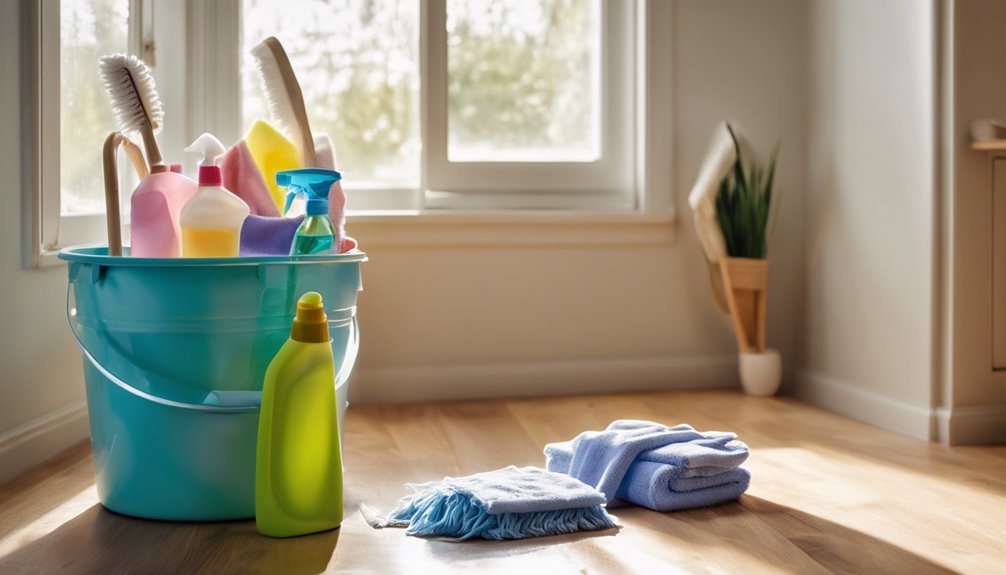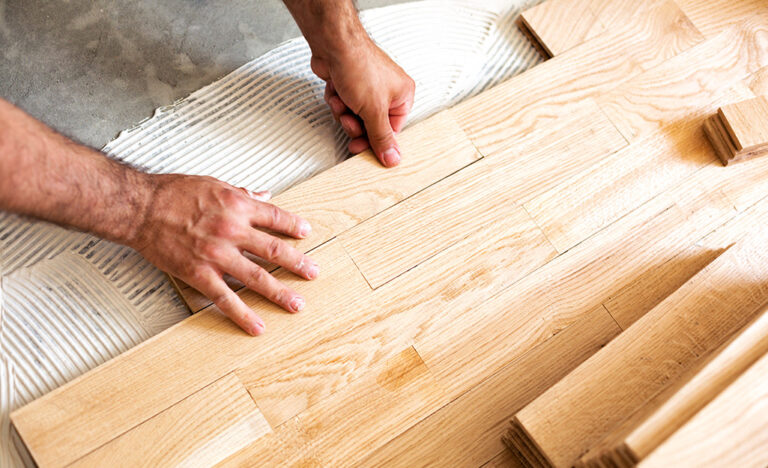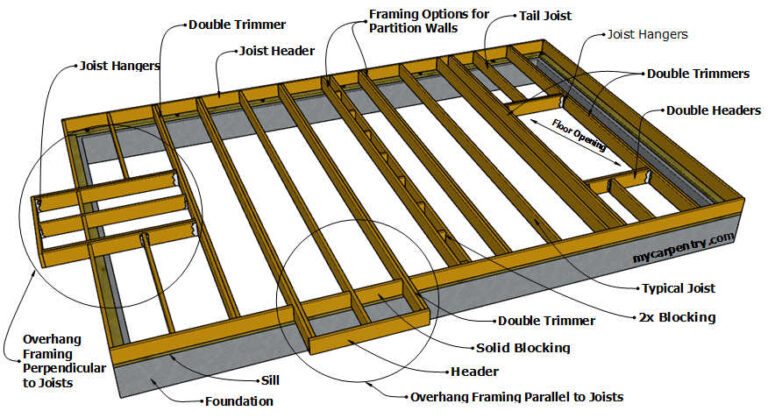To clean linoleum floors effectively, start by gathering your supplies—broom or vacuum, microfiber mop, and a gentle cleaner like vinegar mixed with warm water. Begin by sweeping or vacuuming to remove loose dirt. Next, mop the floor in sections using a figure-eight motion to avoid streaks. For stubborn stains, use a soft cloth with a suitable cleaner, testing it first on an inconspicuous area. Rinse your mop frequently and guarantee the floor dries completely. Regular maintenance helps keep your floors looking their best. There's more you can learn about specific techniques and products to enhance your cleaning routine.
Gather Your Cleaning Supplies

Before you get started, it's essential to gather your cleaning supplies. Depending on the linoleum types in your home, you'll need specific tools for effective cleaning. First, grab a broom or a vacuum to remove loose dirt. A microfiber mop works wonders for deeper cleaning, especially when paired with a suitable cleaning solution. Make sure you have a bucket for mixing your cleaning solution, which can be a simple mix of warm water and vinegar. Don't forget to have a soft cloth or sponge handy for spot cleaning stubborn stains. If you have any specialized cleaners for linoleum, keep those nearby too. With the right cleaning tools, you're already on your way to keeping your floors looking great!
Sweep or Vacuum the Floor
Start by sweeping or vacuuming the floor to remove any loose dirt and debris. This step is essential for achieving a clean surface before mopping. Depending on your preference, you can choose between different vacuum types or implement effective sweeping techniques.
- Use a broom with soft bristles for delicate areas.
- Opt for a vacuum with a beater bar for deep cleaning.
- Try a dust mop for quick touch-ups.
- Consider a robotic vacuum for effortless maintenance.
Whichever method you choose, make sure you're thorough, tackling corners and edges where dirt tends to accumulate. By effectively removing debris, you'll set the stage for a successful deep clean, allowing your linoleum floors to shine and remain in great shape.
Prepare the Cleaning Solution

To effectively clean your linoleum floors, it's essential to choose the right cleaner. You'll need to mix the cleaner according to the recommended proportions for the best results. Let's explore the methods and ingredients that will make your floors shine.
Choosing the Right Cleaner
Choosing the right cleaner for your linoleum floor is essential for maintaining its appearance and longevity. You've got options, and selecting the best one can make a difference in your cleaning routine. Consider the following:
- Natural cleaners: Eco-friendly and safe for kids and pets.
- Commercial cleaners: Effective but may contain harsh chemicals.
- pH-balanced solutions: Gentle on your floor while providing a thorough clean.
- Homemade cleaners: Cost-effective and customizable to your preferences.
Whether you opt for natural or commercial cleaners, make sure they're specifically designed for linoleum to avoid damage. Your choice should align with your values and lifestyle, ensuring a clean, healthy home without compromising your freedom to choose.
Mixing Proportions and Methods
Getting the right proportions for your cleaning solution is essential for effectively cleaning linoleum floors without causing damage. Start with a basic mixture of one cup of white vinegar or a few drops of mild dish soap in a gallon of warm water. This cleaning ratio is gentle yet effective. If you prefer a commercial cleaner, follow the manufacturer's instructions for solution types, ensuring you mix it according to specified ratios. Always test any solution on a small, inconspicuous area first. Remember, using too much cleaner can leave residues that attract dirt, while too little might not clean effectively. Stick to these guidelines, and you'll maintain your linoleum's shine while keeping it damage-free.
Mop the Linoleum
Mopping the linoleum is essential for maintaining its shine and prolonging its lifespan. To achieve the best results, choose the right mop types and mopping techniques that suit your needs. Here are some tips to get started:
- Use a microfiber mop for effective dirt removal.
- Opt for a sponge mop for scrubbing tough spots.
- Verify your mop head is clean before each use.
- Mop in sections to avoid missing any areas.
Begin by dampening your mop with the cleaning solution, then glide it across the floor in a figure-eight motion. This technique helps you cover more ground while preventing streaks. Regular mopping keeps your linoleum looking fresh and vibrant, allowing you to enjoy your space without worry.
Address Stains and Spots

Stains on your linoleum floor can be frustrating, but knowing how to tackle them makes a big difference. First, you'll want to identify common types of stains, then use effective spot treatment methods to remove them. Finally, consider preventive care tips to keep your floors looking clean and fresh.
Identify Common Stains
What kinds of stains do you commonly encounter on linoleum floors? Knowing the stain types can make a big difference in how you tackle them. Here are some common culprits:
- Food spills (like sauces and oils)
- Beverage stains (coffee, wine, or juice)
- Dirt and mud tracked in from outside
- Ink or dye marks
Each stain requires specific cleaning techniques for effective removal. For instance, grease from food may need a degreasing solution, while ink could require rubbing alcohol. By identifying the stain type first, you can choose the right approach, making cleaning quicker and easier. Stay ahead of those stains, and keep your linoleum floors looking fresh and inviting!
Spot Treatment Methods
Once you've identified the type of stain on your linoleum floor, it's time to tackle it with the right spot treatment method. For grease stains, apply a few drops of dish soap mixed with warm water and scrub gently. For ink or dye, consider using rubbing alcohol on a clean cloth—just don't soak the area. If you're dealing with food stains, a paste of baking soda and water can work wonders. Always test stain removal products on an inconspicuous area first to avoid damage. Remember, using effective spot cleaning techniques is key to maintaining your floor's appearance. After treating the stain, rinse the area with clean water and dry it thoroughly to prevent residue build-up.
Preventive Care Tips
To keep your linoleum floors looking their best, it is essential to implement preventive care measures that address stains and spots before they become a problem. Here are some effective tips for floor protection:
- Place mats at entryways to catch dirt and debris.
- Use furniture pads to prevent scratches from heavy items.
- Clean spills immediately to avoid staining.
- Regularly sweep or vacuum to remove loose particles.
Rinse With Clean Water
After you've mopped the linoleum floor, rinsing with clean water is essential to remove any remaining cleaning solution and dirt. Start by preparing a bucket with clean water at a warm, but not hot, temperature. Warm water helps dissolve any stubborn residue more effectively. Use rinse techniques like a damp mop or a clean cloth to go over the entire floor. Make sure to wring out the mop or cloth well to avoid excess water pooling on the surface. Rinse sections of the floor, ensuring you cover every nook and cranny. This step not only enhances the cleanliness of your floor but also prevents any sticky or slippery surfaces that could compromise your freedom of movement.
Dry the Floor Properly

Although drying your linoleum floor might seem straightforward, it's crucial to do it properly to maintain its appearance and longevity. Here are some effective drying techniques to take into account:
- Use a clean, dry mop or cloth to absorb excess moisture.
- Open windows or doors for ideal ventilation, allowing fresh air to circulate.
- Use fans to speed up the drying process and reduce humidity levels.
- Avoid walking on the damp floor to prevent dirt from getting trapped.
Apply a Floor Polish
Once your linoleum floor is completely dry, you can enhance its shine and protect its surface by applying a floor polish. Start by selecting a polish suitable for linoleum, as different floor types may require specific products. Before the polish application, read the instructions carefully to guarantee peak results. Using a clean mop or applicator, spread the polish evenly across the floor. Work in small sections, applying a thin layer to avoid buildup. Allow the polish to dry completely, which typically takes about 30 minutes. Once dry, you'll notice a beautiful sheen that revitalizes your space. Regularly applying polish can prolong the life of your linoleum and keep it looking fresh, providing you with the freedom to enjoy your home.
Regular Maintenance Tips

To keep your linoleum floors looking their best, regular maintenance is essential. This not only enhances their appearance but also extends the linoleum lifespan and improves floor durability. Here are some tips to contemplate:
- Sweep or vacuum regularly to remove dirt and debris.
- Mop weekly with a gentle cleaner designed for linoleum.
- Wipe up spills immediately to prevent stains.
- Avoid harsh chemicals or abrasive tools that could damage the surface.
Frequently Asked Questions
Can I Use Bleach on Linoleum Floors?
You might be wondering if you can use bleach on your linoleum floors. While bleach can disinfect, it can also damage the surface, leading to discoloration. Instead, consider bleach alternatives like vinegar or baking soda, which are effective cleaning solutions and safer for your flooring. These options not only clean but also preserve the integrity of your linoleum. Always test any cleaning solution in a small area before applying it widely!
How Often Should I Clean My Linoleum Floors?
You might think daily cleaning's a hassle, but a simple routine can save you time in the long run. For linoleum floors, a light daily maintenance sweep or mop keeps dirt at bay, while a deeper clean every week or two helps maintain their shine. Establishing a cleaning schedule not only preserves your floors but also enhances your living space. Consistency is key, so find a rhythm that works for you!
Is It Safe to Use a Steam Mop?
Using a steam mop on linoleum can have both benefits and risks. The steam mop's benefits include deep cleaning and sanitizing, which helps remove dirt and allergens effectively. However, it's essential to be cautious, as excessive heat and moisture can damage the linoleum over time. Make sure to follow the manufacturer's instructions and avoid using it on high settings. With proper care, you can enjoy a clean floor without compromising its longevity.
What's the Best Way to Remove Wax Buildup?
To tackle wax buildup effectively, you'll want to contemplate a few wax removal techniques. Start by applying a commercial wax remover suitable for linoleum floor care, following the manufacturer's instructions. Alternatively, mix vinegar and water for a DIY solution. Apply it to the affected area, let it sit briefly, then scrub gently with a soft cloth. Rinse well afterward. Regular maintenance helps prevent buildup, keeping your floors looking their best without too much effort.
Are There Any Specific Products to Avoid?
When it comes to floor maintenance, you should steer clear of harsh cleaning solutions like bleach or ammonia. These can damage your flooring and create an unhealthy environment. Instead, look for pH-neutral cleaners specifically designed for your type of flooring. Avoid wax-based products, too, as they can lead to buildup over time. By choosing the right solutions, you'll keep your floors looking great without compromising their integrity.



